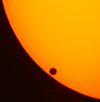Wikipedia:Today's featured article/June 5, 2012
A transit of Venus across the Sun takes place when the planet Venus passes directly between the Sun and Earth, becoming visible against the solar disk. During a transit, Venus can be seen from Earth as a small black disk moving slowly across the face of the Sun. A transit is similar to a solar eclipse by the Moon, but while the diameter of Venus is more than three times that of the Moon it is much further from Earth and so appears smaller and generally takes longer (up to eight hours) to travel across the solar disk. Transits of Venus are among the rarest of predictable astronomical phenomena—they occur in a pattern that repeats every 243 years, with pairs of transits eight years apart separated by long gaps of 121.5 years and 105.5 years. The next transit of Venus occurs on 5 and 6 June 2012, and will be the last Venus transit this century. Historically, Venus transits were of great scientific importance as they were used to gain the first realistic estimates of the size of the Solar System. A transit of Venus can be safely observed by taking the same precautions used when observing the partial phases of a solar eclipse. (more...)
Recently featured: Japanese aircraft carrier Kaga – Sweet Track – Elizabeth II

